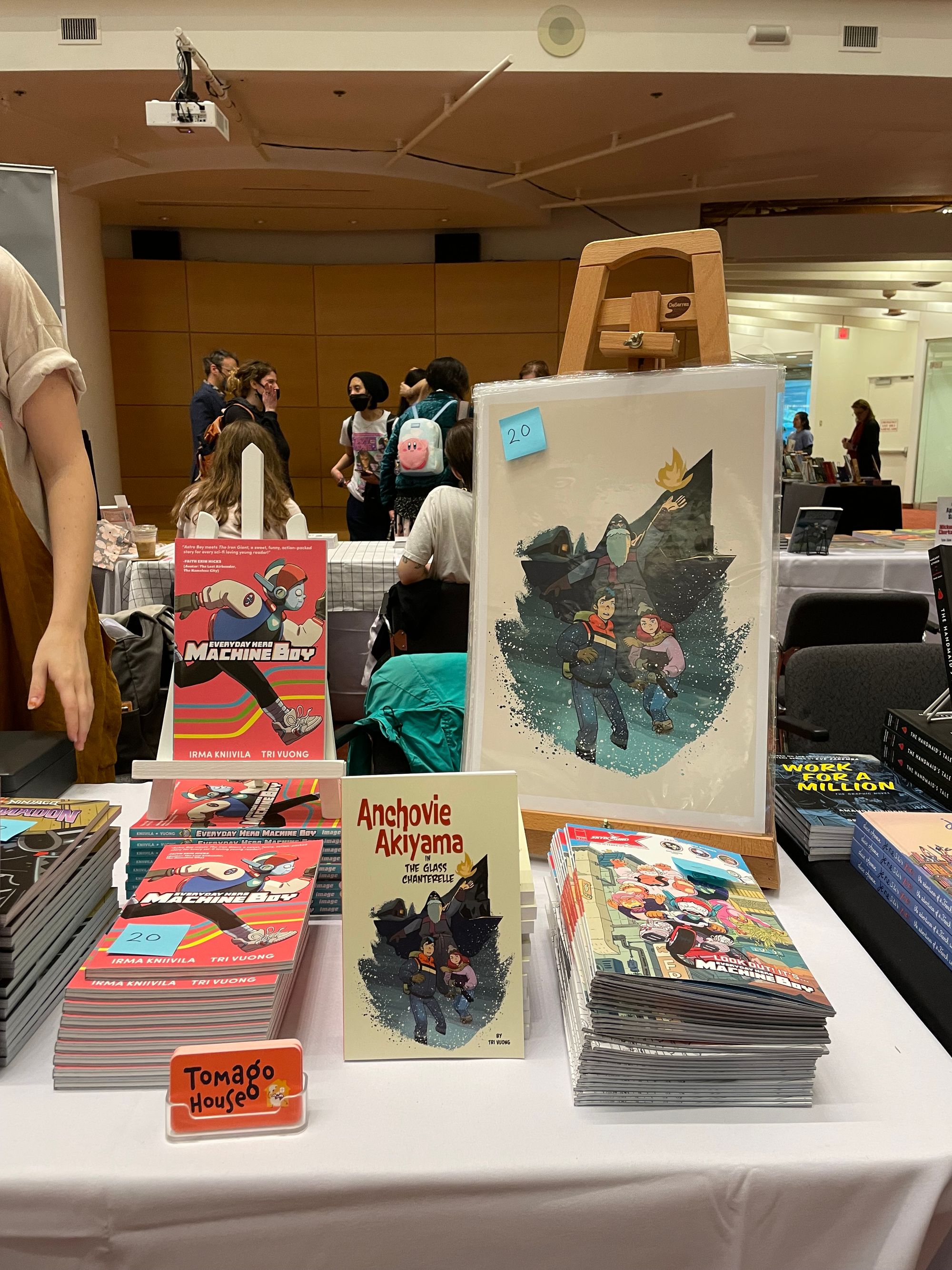Tomago House #7: TCAF Post Mortem

Welp, I survived TCAF and had a great time doing so!
This was my first convention in six or seven years (I'm naturally a bit of a hermit) but since I have actual books now to promote, I'm doing my darnedest to pull up my big boy pants and put myself out there and actually tell people about my work.
Overall, I had a really great time at TCAF and I think it was quite the success. I thought it would be interesting to do a little post mortem based on everything leading up to convention.
Initial Goals.

I had two goals when I first decided to have a table, and neither of them involved turning a profit (a fact that will become obvious soon).
The first was to let people know about Everyday Hero Machine Boy, the middle grade graphic novel I co-created with Irma Kniivila. I love the heck out of this book and really hope it finds an audience. Although it's marketed towards kids age 8 to 12, Irma and I didn't write the book with any audience in mind other than ourselves. It's a really quirky, action packed book and I'd like to think that anybody of any age can read it and enjoy it.
The second goal was to give myself a project to force me to get off my butt and learn how to make an actual book. Thus far, my part in a comic was finished once the story and art was done and I left the actual production of a book to more capable hands. But I always wanted to make an actual physical thing that I could hold in my hands by myself, even if it was just this one time.
Printing costs monies.
I've already covered some of the difficulties of turning Anchovie Akiyama from a webcomic into print form so I'll just get straight into the nitty gritty details of printing costs.
The cost of printing a book is inversely proportionate to the number of books you want made. To put it simply: the more books you print the cheaper each book will be and the more profit you will make per book.
However, this was more of an experiment for me and I didn't want to invest TOO much money into this project the first time out. After all, I had no idea whether anybody would actually want to buy a copy of Anchovie Akiyama and I didn't want to have thousands of books sitting in my basement, each unsold copy shaming me with their judgemental eyes.
What's that you say? I should run a kickstarter to cover the printing costs and to guage pre-orders? Why, that's a fabulous idea!
Unfortunately, I have no experience with Kickstarter either and running one while trying to figure out how to assemble a comic would have just have overloaded me. I do have a day job after all and tackling TWO new side projects at the same time seemed like a sure fire recipe for disaster. I regularly broke out in stress hives just dealing with printing issues alone.
Ultimately, I decided fifty copies of Anchovie Akiyama would be a good print run for this test. I figured if I sold fifty books in one weekend, I'd be pretty happy. But if I didn't sell any, I could keep them as souvenirs or foist them onto friends and relatives as gifts, thereby recouping my costs by not having to buy Christmas presents for a couple of years (hehehe.. schemes within schemes).
The cost of each book worked out to be $14 per book after tax and shipping, for a total of about $700. This is a pretty high figure for such a small digest sized book but not a surprise considering my tiny print run. The sum was high enough to feel a little nervous (no Playstation 5 this year I guess), but not so high that it would devastate me if this venture was catastrophic failure.
I priced the book at $20 dollars so I could at least still make a modest profit of $6 a book. This was good enough for me this time around.
So how did it go?
To tell you the truth, better than expected. I ended up selling quite a few Everyday Hero Machine Boy, a few Ninjago: Garmadon and ALL of my copies of Anchovie Akiyama (most of them were gone by the end of the first day). Of course, every show is different and TCAF in particularly favors the quirky indie comics over established brands, but all in all it was a very encouraging sign.
More than that, it was a pleasure to meet fans, old and new, and run into familiar faces. Most people hadn't heard of Anchovie Akiyama, so it was especially gratifying to see someone pickup the book out of curiousity, smile, and then decide to purchase a copy. It was particularly gratifying to see someone pick up Anchovie Akiyama the first day, read it overnight, and come back the next day to grab a copy of Everyday Hero Machine Boy (or vice versa).
It was also a real thrill to share a table with Rebecca Mock, an artist I've admired for a long time. Her book, Salt Magic, was the best thing I read in years and I can't recommend it enough. If there's any justice in the world, Salt Magic will be a timeless classic.

Next Steps.
I'd definitely like to setup an online store of some sort but I also sold most of my books so another print run will be necessary. It would be easy to do another modest print run and sell them online as a fun side project but I've been really curious about ordering a greater amount to drive down the cost per book to more reasonable amounts.
A larger run of 2,500 copies from the same printer could get costs down to around $5.50 a book. This would be alot more profitable but the cost of printing would be over $13,000! I would definitely need to run a kickstarter for that.
Another thing I need to consider is how would I go about storing and selling all these books? I could probably just cram them into my basement or studio, but I'd have to devote alot of time contacting retailers or attending conventions to try and sell them. That would mean time away from actually making comics.
As you can see, there's alot to consider. But dont' get me wrong, I'm not complaining! It's a tremendous amount of fun to puzzle this out, I just need to find the best way to use my time.
I hope this was an interesting and informative read. If you are also trying to self publish your own comic and have any questions or comments, I'd love to hear from you. Feel free to leave a comment below!
Tri

